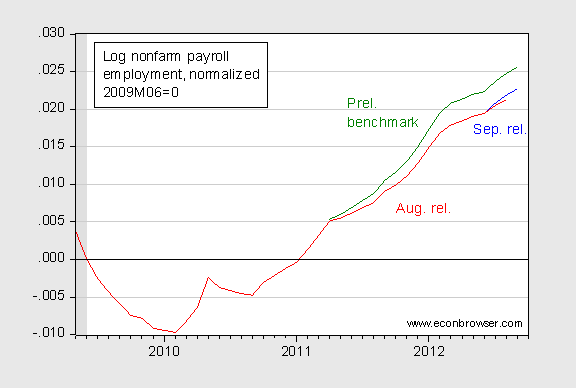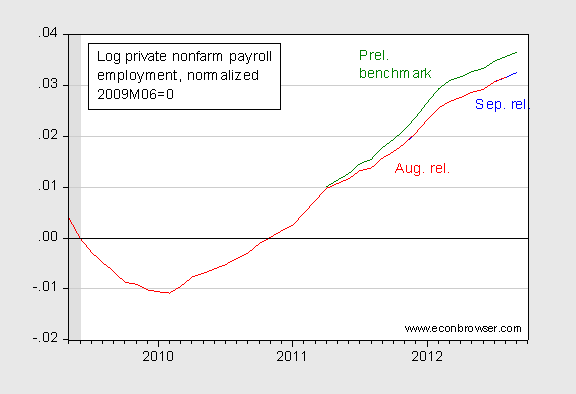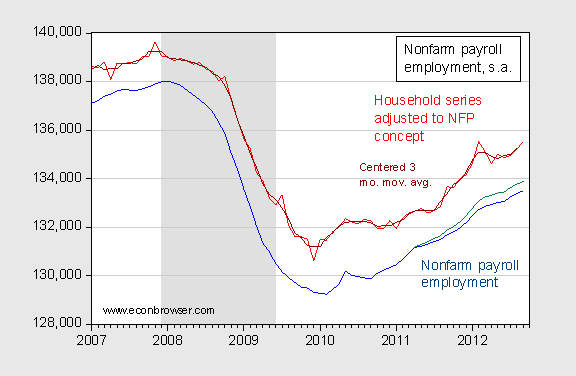With the September employment release, average monthly employment figures over the last four months is 120.5 thousand, versus the three month average as of the August release of 94 thousand. Furthermore, taking into account the preliminary benchmark revision for March 2012, one sees that not only is the trajectory higher, so too is the level of employment.

Figure 1: Log nonfarm payroll employment, September release (blue), August release (red), and September release, adjusted by March 2012 preliminary benchmark release (green) (see this post), all seasonally adjusted, normalized to 2009M06=0 (NBER trough). NBER defined recession dates shaded gray. Source: BLS via FRED, BLS, NBER and author’s calculations.
The March 2012 preliminary benchmark revision, based on more complete records, is assumed to apply linearly to the level of employment over 2011M04-2012M03 (i.e., “wedged in”), and assumed to hold constant thereafter.

Figure 2: Log private nonfarm payroll employment, September release (blue), August release (red), and September release, adjusted by March 2012 preliminary benchmark release (green)(see this post), all seasonally adjusted, normalized to 2009M06=0 (NBER trough). NBER defined recession dates shaded gray. Source: BLS via FRED, BLS, NBER and author’s calculations.
Figure 3 provides context. Note the series, based on the household survey, adjusted to conform to the NFP concept also rose.

Figure 3: Nonfarm payroll employment, September release (blue), household series adjusted to NFP concept (red), 3 month centered moving average of adjusted series (dark red), and September release, adjusted by March 2012 preliminary benchmark release (green line) (see this post),all seasonally adjusted. NBER defined recession dates shaded gray. Source: BLS via FRED, BLS, BLS, NBER and author’s calculations.
More discussion at WSJ RTE/Dougherty, WSJ RTE/Casselman, and CR1 CR2.
The resilience continues to surprise me, given all the problems in the world economy and the continued paying down of household debt.
I wonder about one thing, Menzie: how much is due to stability rather than growth? That is, for some time employers seem to have held off on hiring, which is natural given the extreme shock of the financial catastrophe. We saw increased productivity – and the silly talk about structural unemployment. Now it seems like some of the hiring may be employers filling positions because they’ve become convinced that stability is real. That is a good thing, a good base perhaps, but it isn’t much in the way of growth.
Menzie-
120.5 K new-employed/month does not even equal the 150 K young adults entering the workforce each month… Such anemic performance is particularly poor considering the $1.2 Trillion/Year in Federal Deficit Spending which has continued since 2009…
Employment performance is so bad that the FED committed to a $40 Billion/Month QE3 gift to the banking industry in September. America is drowning, the only difference is that, at the moment, we’re not sinking quite as fast.
The Employment Situation Report statistics gloss over the quality of employment. Number of jobs is largely irrelevant, if the quality of jobs is declining faster than the quantity of jobs is increasing.
The vast majority of the new jobs reported in today’s survey were part-time jobs. This continues the general trend since since 2009. After accounting for population growth the economy is on balance shedding full-time positions with benefits, and is only treading water in terms of part-time positions at lower pay and no benefits. This is better than nothing, but it’s not a net win for the economy. We need to see something like median real household income rising, to really consider this a healthy economic recovery.
This month there was also a statistically anomalous rise in jobs taken by 20-24 year olds, vs a longstanding historical pattern of job losses in September (presumably as these folks leave summer work and return to college). One is tempted to suspect that someone forgot a minus sign in the table. Correcting that would be a -200K swing. But alternatively, it might be that a lare cohort of college students has collectively realized that it’s better to work part-time in college rather than take out lifetime student loan debt. That might be the best thing they could learn this year!
Try to be a corporation and get away with those kinds of revisions to earnings. Oh, we took a closer look and our earnings are now 36% higher than we told you before… of course that’s just another estimate, but you should buy our stock now even though you wouldn’t last month.
Bruce Hall Try to be a corporation and get away with those kinds of revisions to earnings
If you did, then they would offer you a position on Wall St as a “Job Creator” hero selling CDOs and toxic MBS.
MarkS considering the $1.2 Trillion/Year in Federal Deficit Spending which has continued since 2009…
You have a very weak understanding of how deficits stimulate aggregate demand. It’s the magnitude and the direction of the change in the deficit that matters. And oh by the way, the deficit is going down.
MarkS 120.5 K new-employed/month does not even equal the 150 K young adults entering the workforce each month…
The revised data shows that over the last 12 months the economy has been adding about 150K jobs per month, not the 120.5K you seem to believe.
Furthermore, taking into account the preliminary benchmark revision for March 2012, one sees that not only is the trajectory higher, so too is the level of employment.
So too is food stamp usage…
A current joke during similar times
Politician:
“We have created three million jobs”
Answer,from an attendant to the political meeting:
“Yea,I have four of them”
2slug,
“If you did, then they would offer you a position on Wall St as a “Job Creator” hero selling CDOs and toxic MBS.”
… but it’s okay for the BLS???
Oh, wait. You understood what I meant.
It is rather ironic to see Jack Welch question the BLS numbers, which everyone knows are quite noisy and subject to large revisions. Jack Welch is the guy that for 40 consecutive quarters used shady earnings management manipulations to hit his earnings numbers to the penny, a statistical impossibility. Noisy numbers are expected. Perfectly noiseless numbers are evidence of fraud. Wacko Jack Welch should be in jail rather that spouting absurdities on TV. Shame on the media for feeding the crazy conspiracy theories.
We are right back to the Clinton era where mainstream news media and high level Republican leaders openly promoted the idea that Clinton had a long series of people murdered.
Jack Welch’s claim that somebody cooked the numbers is being widely rejected on the grounds that it would be impossible to get a conspiracy among the BLS bureaucrats sufficient to do that. This is missing the possibility of doing it outside of the bureaucracy. All someone needs is to get a list of some of the names of the households in the 50,000 or 60,000 household sample and go out and hire a few of those people. After all, they don’t take a new sample every month; the same households are used month after month. Jack Welch rightly emphasizes that the sample size is small and vulnerable to mischief.
I find Ben Franklin’s observation the most apt when discussing conspiracies:
Three can keep a secret, if two of them are dead.
Craig Marxsen Perhaps someone hired them to fly black helicopters and mint Woodrow Wilson dimes.
The reason Jack Welch shouldn’t be taken seriously is that apparently he never took an econometrics class. The movement in the household survey numbers was not all that unusual. There is a certain amount of irreducible noise in the data. There’s also the fact that several of the previous monthly surveys seemed especially pessimistic given the data from the establishment and automated payroll surveys. Jack Welch is a kook, plain and simple.
There are many questioning the 800k jump in employment in the household survey, but they do not seem to notice the 200k decline during the previous two months. If you average over the three months (for this notoriously noisy series) then the household numbers are roughly in line with the payroll numbers.
I think is is easy to make the case that the economy has been slowly healing for the past two years, unemployment declining and jobs increasing, the housing market stabilizing and now growing, households deleveraging. None of this is as fast as we would like, but the direction is clear.